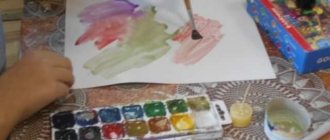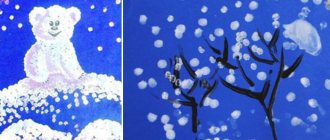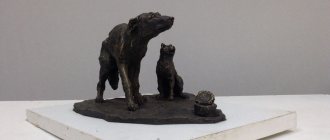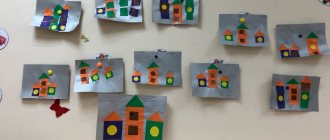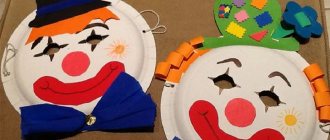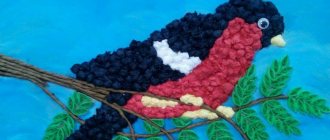Maneki-neko in paper version
Usually matryoshka cats are made of wood. But even if they are made of paper using the origami technique, they are unlikely to lose their “magic” functions. For the Japanese talisman “for good luck” you will need 4 square sheets of different colors, sizes 15x15, 13x13, 11x11 and 9x9 cm.
Step-by-step instruction:
- We take the largest square blank.
- We place it with the top forward, fold it in half from bottom to top.
- We bend the left corner obliquely so that its top “rests” against the opposite edge.
- We do the same with the right one.
- Fold the top layer of the triangular flap forward.
- We tuck it into the lower trapezoidal “pocket”.
- We bend the second layer of the valve. We put it inside the resulting “glass”.
- Turn the workpiece 180°. We press our finger on the upper part of it to mark the ears. We draw the cat's face, as well as a tail and paws. According to Japanese tradition, one of them can be raised to attract good luck.
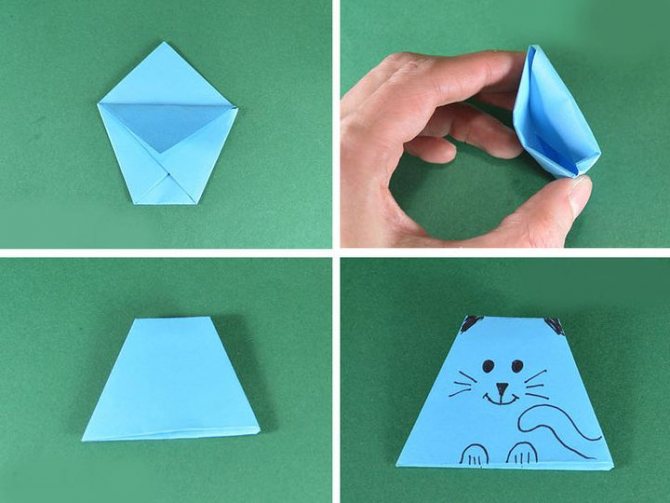
With a paper maneki-neko, young children will be able to act out theatrical scenes, inventing their own character for each member of the cat family. So, along with logic, an unusual nesting doll will allow you to develop your imagination.
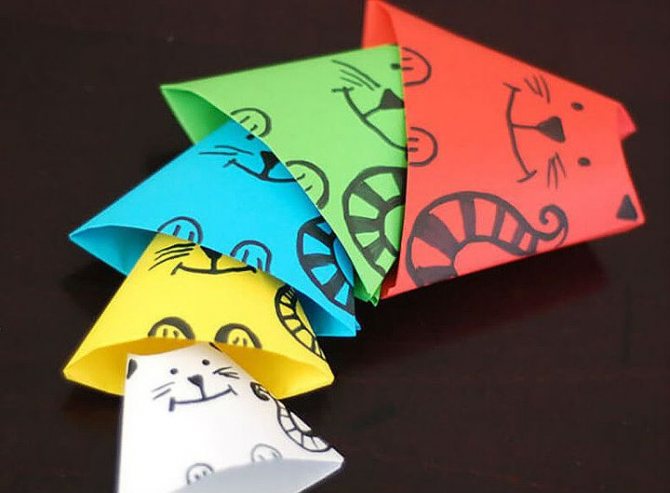
If maneki-neko seems too exotic, the same scheme is suitable for making a classic Russian origami matryoshka doll. There is no need to press the figure with your finger at the top. The rest of the assembly algorithm is absolutely identical.
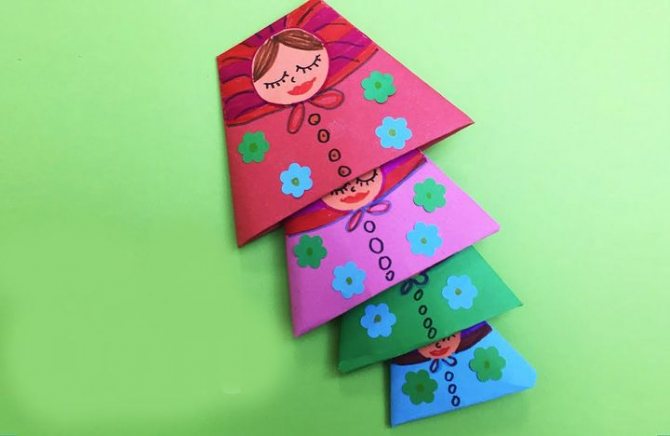
Item
: labor training
Date:28,30.04
Subject:
Application "Matryoshka"
Target:
- using the example of the history of the creation of the matryoshka doll to continue acquaintance with traditional folk crafts of Russia
- continue to develop skills in independent work with paper and cardboard using the applique technique
- develop the creative potential of students in collaborative group work
Equipment:
- collection of nesting dolls
- illustrations with nesting dolls (grouped by painting style)
- large format templates - outlines of matryoshka dolls
- glue, brushes, rags for dipping
- instrument nameplates
Preparatory work:
- children cut out drawings of flowers, leaves, twigs, various patterns, etc. from scrap and scrap packaging in advance.
During the classes.
I. Organizational moment. Lesson motivation.
Today in class we will meet with a toy. This toy is not simple: it is known all over the world. True, the translation of the word - the name of this toy - cannot be found in any dictionary in the world. But everyone knows what it is. For example, in Germany they call her differently: “Grandmothers”, “Mommies” or even “Aunt Olya”.
But in Rus' they came up with a riddle about this toy:
Wooden girlfriends are so similar to each other. There are many of them or a little, But their names are all... (MATRYOSHKA)
II. Exhibition of nesting dolls.
Teacher:
Here they are, Matryoshka dolls, All of them are cute... All with scarlet cheeks Under colorful scarves, Smart, pretty, a little like you...
— Guys, have you noticed that at our exhibition the beautiful dolls are arranged in “families”, “groups”. Why do you think? (Children's guesses)
It turns out that in truly folk crafts, several main styles of painting and making nesting dolls can be distinguished:
- Semenovsky (Semenovo) (Fig. 1)
- Vyatsky (Vyatka) (Fig. 2)
- Merinovsky (village Merinovo
- Zagorsky (Sergiev - Posad - Zagorsk) (Fig. 3)
- Polokhovsky (village Polokhovsky Maidan) (Fig. 4)
Rice. 1
Rice. 2
Rice. 3
Rice. 4
III. The history of the creation of the nesting doll.
Teacher: But where did this name come from - matryoshka? (children's statements)
— Some historians claim that this name comes from the beloved and common names in Rus' Masha, Manya, Matryoshenka; others - that this name comes from the female name Matryona (translated from Latin mater - mother), and still others believe that the name “matryoshka” is associated with the name of the Hindu mother goddess Matri...
- Well, the most important thing is this doll with a secret:
Is this a dream or reality - I can’t understand at all. There was one nesting doll here, and now there are seven of them. Seven wooden dolls, multi-colored and ruddy, live on our table, they are all called matryoshka dolls. We played, frolicked and all fit into one!
— The first Russian nesting doll was carved and painted in a Moscow toy workshop only in the 90s of the 19th century, based on a model brought from Japan. This Japanese example, made with great humor, consisted of many figures of the Japanese sage Fukuruma inserted into each other - a bald old man with his head stretched up from numerous thoughts (Fig. 5).
Toy turner Vasily Zvezdochkin carved the first Russian nesting doll. From the walls of the “Children's Education” workshop, founded by philanthropist Savva Mamontov, came a beautiful, rosy-cheeked maiden painted in gouache with a rooster in her hands, which became the first nesting doll made in Russia. The sketch for its painting was created by the artist Sergei Malyutin, who personally painted the matryoshka doll. The first nesting doll was eight-seater - inside the big girl there was a smaller boy, and so on - boys and girls alternated, and the smallest, “indivisible” doll was a swaddled baby.
Rice. 5
IV. Making an application.
— Which nesting dolls did you like best? Why?
— Would you like to create your own nesting doll together with your friends? Such a matryoshka will be called the author's one. Why do you think? (The class is optionally divided into groups or brigades; each group receives a large-format template - a blank with the outline of a matryoshka doll)
— We will work using the appliqué technique. List what tools we will need.
(As the children answer, the teacher attaches signs with the names of the tools to the board; the order of the work is discussed)
Let's call the kids! We offer you a game: Take the tools and bring the nesting doll to life!!!
V. Exhibition of student works.
Each group demonstrates its own nesting doll. Children offer names for their “author’s” style of decorating the doll. Organizing a public exhibition of works (in the classroom, corridor, on the floor)
Possible assignment after class:
- select interesting material for the “Russian Matryoshka Book of Records”; If desired, messages “From the history of the “costume” of the Russian nesting doll”, “Secrets of the nesting doll museum”, etc. are prepared.
Summary of direct educational activities in the senior group “Matryoshka”
Lesson notes on the application “Matryoshka”
MBDOU No. 62 “Rodnichok”
Authors: Kazachkova Elizaveta Sergeevna - teacher,
Dvoretskaya Elena Arkadyevna - teacher
Age:
senior group
Subject:
"Matryoshka"
Purpose of the lesson:
To promote the ability to create an image of a folk toy (matryoshka) using the appliqué technique.
Tasks:
1. Teach children to analyze a sample to identify characteristic features
(Components: face, hands, sundress, scarf)
2. Teach children to consciously select matryoshka parts in the chosen color scheme.
3. Continue training in work planning.
4. Teach how to capture an idea in an original artistic image.
5. Continue teaching how to cut out an object using a stencil and carefully stick on the applique elements
Equipment:
paper, fabric, glitter, scissors, glue, brush, pencil.
Bibliography:
Arapova S.V. Fine arts training. Integration of artistic and logical. - St. Petersburg: KARO, 2004. - (Modernization of general education).
Gusakova M. A. Application. - M.: Education, 1982.
Dubrovskaya N.V. Invitation to creativity: teaching preschoolers the technique of appliqué and collage. - St. Petersburg: “CHILDHOOD-PRESS”, 2004. - 128 p.
Progress of the lesson:
Organizing time.
Hello guys.
What could such a box be filled with?
Of course, with old Russian things. I'll tell you a secret. The box is filled with toys.
So, let's open the box? I'm looking for a wonderful toy. Guess which one?
We're at the fair
They brought you a chest - a gilded barrel. That chest is not simple, and the goods in it are painted. We take it out for display - And we tell a story about it.
A scarlet silk scarf, a bright sundress in a flower, resting the hand on the wooden sides. And inside there are secrets: Maybe 3, or maybe 6. She didn’t blush a little (children’s answers...? Matryoshka)
Presentation and conversation.
Now I’ll tell you guys about this wonderful toy – a matryoshka. After all, you probably have such a house and a toy?
Who has?
The first Russian matryoshka was an eight-seater: a girl with a black rooster was followed by a boy, then a girl, and so on. All the figures were different from each other. The last one, the eighth, depicted a baby.
Initially, this doll didn’t even have a name. But when the turner made it out of wood, the artist painted it with bright colors, then the name appeared - M?atryona. Perhaps this is due to the fact that at various evenings tea was served by a servant with that name. Why was everyone’s favorite Russian doll-toy called “matryoshka”? Many believe that this name comes from the female name Matryona, very popular at that time in Russia. The name Matryona, translated from Latin, means “noble woman.” Looking at the matting doll, the image of a portly, noble and toy really appears.
